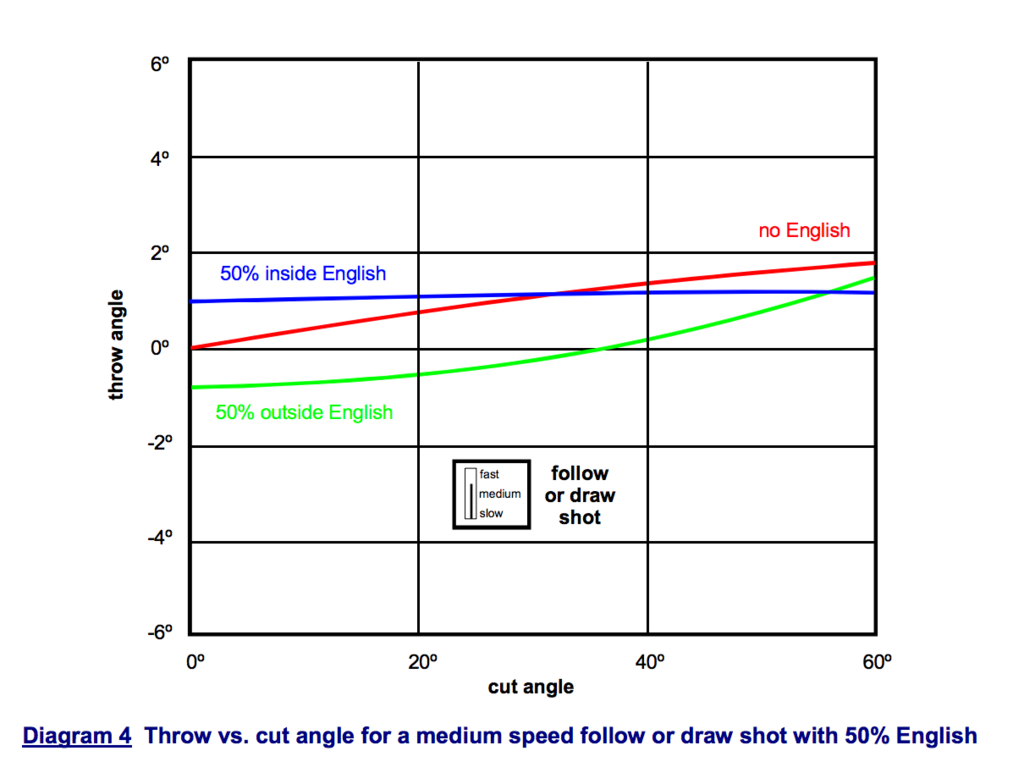My comment was only about how to produce maximum throw, not about its application to TOI, but...
Interesting observation about variance in throw with inside vs. outside - I'll have to spend some time with Dr. Dave's analysis before I can speak to that. But I don't recall throw being part of CJ's "reasoning" - as I recall he was focused entirely on using squirt to improve pocketing percentages. Throw has the opposite effect of squirt on aiming, so I wonder how that factors into your assessment of TOI.
You might be right about favoring inside for shots that don't need CB control, but in my experience that situation is rare even for game balls.
pj
chgo
I don't trouble myself worrying too much about what CJ thinks is happening. I am interested in what is really happening. Like many pro-level players in sports of various kinds, CJ does things right a lot more often than the rest of us mortals. The fact that he cannot explain or provides a faulty explanation for techniques he uses is not evidence that the techniques is wrong or would not work in the hands of others. The discussion above of Willie, arguably the goat, who could execute but not properly explain the mechanics of what was happening, and was making money off the video, is an example that a pro can sincerely try to help others, be incorrect in the explanation, yet right about the execution, all while making money in our wonderful capitalist system which rewards people with skills and work ethic who want to teach others their skills.
I have tried some of the techniques CJ teaches on here and in his cds. In every case I have not been successful at understanding what to do regarding some of his more controversial methods based on CJs direct instructions. I have needed an interpreter in the form of someone on this or another forum who figured it out and explained it better, or I figured it out on my own. My conclusions are that TOI and the so-called hammer stroke which is not remotely like striking a hammer by the way, are both valid methods which in the former case reduced misses for me mainly on 0-30 degree shots, got me hitting at a more consistent speed which allowed for shape using mostly high and low and only spinning as needed, and in the latter case provided me with a more abbreviated, straighter stroke.
I think there are two reasons this latter stroking method has advantages. First, from a starting position with the wrist flexed forward the fingers are forward of the lower arm, and they are very close to the finish position for most shooters. So the cue stick is pushed rather than pulled forward as it would be with the wrist flexed back, like John Schmidt, who starts with wrist cocked back (ulnar) and ends with it cocked forward (radial).
In contrast, CJ starts with his wrist cocked forward, and ends with his wrist cocked forward. Shane does too. They are setting their wrists in the same position at the beginning as at the finish, the stick rocks back in the hand some but the wrist remains cocked forward in both cases. CJ says you can't see the hammer move happening, and that is because it is not happening. It can't, since he is applying some downward pressure at the beginning of the stroke with his wrist flexed radially and there is nowhere for it to go from there since the stick does not move downward at that location (with respect to the cue, it is moving downward with respect to the table at the same angle as the cue). It would be like holding a hammer up against a nail and then trying to do a hammer stroke. You can't. You have to raise the hammer up to strike and you would have to raise the stick off the bridge to do a hammer stroke. Is his wrist flexed more forward? Perhaps, because he is reaching forward more during the follow through. He may feel like it is turning down substantially but it is dead obvious from videos of him that he isn't. In fact he is largely taking the wrist out of the picture and pushing the stick forward without changing wrist orientation much.
The second reason this stroking method has advantages in my opinion is that because the wrist flexure is not changing much, some downward pressure can be applied on the stick, which will certainly cause problems if you are changing from flexed back to flexed forward, but is an advantage when maintaining the forward flexure, because it holds the stick down into the original bridge position, it does not waver as much, and because the wrist is locked it does not interfere.
That is my point of view on those two things. Meanwhile, while I listen to CJs explanation of what he thinks is happening, and realize he is right about some things and maybe not so right about others, his inability to explain it does not provide a shred of evidence that the technique does not work, any more than Ted Williams inability to explain all the mechanics of a baseball swing obviates the validity of his techniques.

